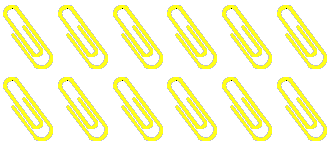

Assuming you had them, you would reach into your desk drawer and hand me
twelve paper clips. Because you know that:
| 1 dozen paper clips = 12 paper clips |  |
Just like a dozen of anything means that I have twelve anythings,
one mole of anything means that I have
602,200,000,000,000,000,000,000
of these anythings.
So if I asked you for a mole of paper clips, what would you do?
You would reach into your desk drawer and hand me
602,200,000,000,000,000,000,000 paper clips!
This is because:
1 mole paper clips = 602,200,000,000,000,000,000,000 paper clips
That's a lot of paper clips, isn't it?
This big number is called "Avogadro's number". We could say:
Avogrado's number = 602,200,000,000,000,000,000,000 items/mole
But to make it easier to read, write and remember, we refer to it this way:
NA = 6.022 x 1023 items/mole
6.022 x 1023 means 6.022 * 1023.
| So, if we were to discuss bicycles:
1 mole of bicycles = 6.022 x 1023 bicycles |
 |
Now, this may seem like a lot of bicycles, but in Chemistry, we usually discuss much smaller objects, like atoms. Atoms are very small. You probably don't have enough space in your driveway for a mole of bicycles, but you certainly have space for many moles of atoms!
two moles of hydrogen atoms = 2 * 6.022 x 1023 hydrogen atoms = 12.044 x 1023hydrogen atoms
two moles of sodium atoms = 2 * 6.022 x 1023 sodium atoms = 12.044 x 1023 sodium atoms
two moles of water (H2O) atoms = 6.022 x 1023 H2O atoms
and so on.
If one bicycle weighs twenty pounds, how much would a dozen bicycles weigh?
20 lbs * 12 bicycles = 240 lbs
I'm just going to rewrite this slightly, using the concept of Dimensional Analysis:
(20 lbs/bicycle) * (12 bicycles/dozen) = 240 lbs/dozen
So now we know specifically that the weight is 240 lbs per dozen.
How much would a mole of bicycles weigh?
(20 lbs/bicycle) * (6.022 x 1023 bicycles/mole) =
1.204 x 1025 lbs/mole
So the molar mass (MM) of bicycles is 240 lbs/mole. Wow!
Now let's talk about atoms. Take a look at your Periodic Table. Hydrogen is the first element listed. Its symbol is H, its atomic number is 1 and it has an molar mass of 1.008 grams/mole.
|
1 H 1.01 grams/mole |
This means that the mass of one mole of hydrogen is 1.01 grams.
Question: What is the mass of one mole of carbon?
|
6 C 12.01 grams/mole |
Question: What is the mass of three moles of carbon?
Answer: 3 * 12.01 grams = 36.03 grams
Question: If you were given 24.02 grams of carbon, how many moles would you have?
Answer: 24.02 grams / 12.01 grams per mole = 2 moles
Great! Piece of cake, right?
Next, let's find the mass of table salt. Its chemical formula is NaCl. That means that one mole of sodium (Na) has combined with one mole of chlorine (Cl).
From the periodic table, we see that Na has a molar mass of 22.99 grams/mole. We also see that Cl has a molar mass of 35.45 grams per mole.
Na: (22.99 grams / 1 mole) x 1 mole Na in NaCl = 22.99 grams
Cl: (35.43 grams / 1 mole) x 1 mole Cl in NaCl = 35.43 grams
Now just add up the masses:
22.99 + 35.45 = 58.44 grams NaCl / mole
Back to Chemistry Tutorials Home Page